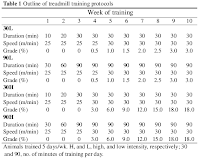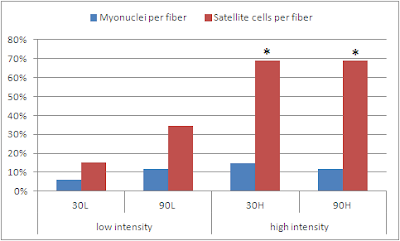 |
| Image 1: NO-mediated satellite cell recruitement (Anderson. 2000) |
While I will go into more detail on how your muscles actually grow in the upcoming parts of the Intermittent Fasting Series, in the course of which I am going to explain how you should train, eat and sleep in order to exploit all three major pathways of skeletal muscle growth, I want to give you a sneak peak at what you are going to learn, by highlighting that protein synthesis, i.e. the accrual of muscle protein in existing myonuclear domains, and the recruitment of satellite cells to replace damaged or add new myonuclei are distinct processes. It should nevertheless be obvious that with all the protein synthesis of the world you will - sooner or later - hit a plateau, when all the existing myonuclei have "blown up" to their maximal size - or as Naito et al. put it: "Increases in the number of satellite cells are necessary for full skeletal muscle growth and hypertrophy" So, whenever the existing myonuclei have reached their "full potential", the only way to keep growing is by adding new myonuclei via satellite cell recruitment. Keep that in mind before you discard the results the following study, because the "HIT rats" did not gain more "active" muscle than the "LIT rats" ;-)
In their experiment Hasashi Naito and his colleagues from the Tokai University and the Juntendo University in Japan put 17-week old (these are old rats!) female Sprague-Dawley rats on one out of four exercise regimen (for a detailed outline of the regimen, cf. table 1):- High Intensity, High Duration (90H)
- High Intensity, Low Duration (30H)
- Low Intensity, High Duration (90L)
- Low Intensity, Low Duration (30L)
 |
| Table 1: Outline of the exercise protocol (from Naito. 2011) |
As it was to be expected in view of the high age of the rats, where skeletal muscle mass maintenance, may be considered a success, there were no statistically significant increases in plantaris and/or body mass in any of the treatment groups.
 |
| Figure 1: Changes (compared to untrained control) in number of myonuclei and satellite cells per muscle fiber (data calculate base on Naito. 2011) |
 |
| Figure 1: Satellite cells per muscle fiber in type I (slow twitch) and type II (fast twitch) muscle fibers of rats in the control and the high intensity, high duration (90H) groups (data calculate base on Naito. 2011) |
That being said, both the strength training, which would make use of the increased propensity to grow by recruiting satellite cells to form new myonuclei, as well as the necessary local IGF and MGF responses, which have been shown to decrease with age (Grounds. 2002), were absent in the study at hand. In someone like you, a young, vigorous strength trainee, both stimuli will yet obviously be present in abundance (at least I would hope so ;-). Accordingly, 1-3 high intensity (and in view of the fact that the duration, 30 vs. 90min, did not make a difference probably also high intensity interval) training (HIT or HIIT) sessions per week could not only make your increasingly fat-free muscles shine in their full glory, they will also "precondition" you for future muscle growth by increasing your satellite cell pool. I would thus suggest, you better not join the two lazy rats from the study, and rather find yourself the next best track to do a bunch of sprints ;-)










0 comments:
Post a Comment